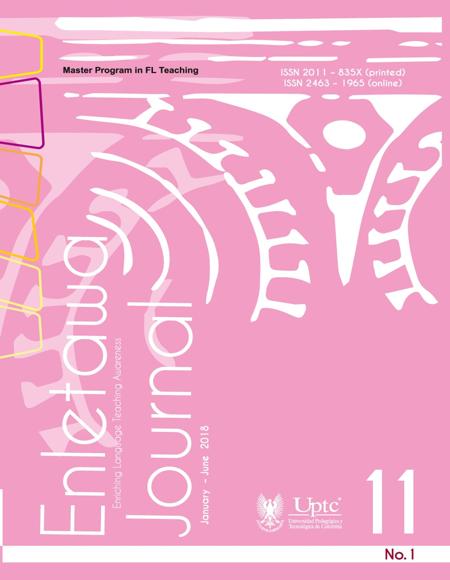Tracing the theoretical path of my teaching experience at a private English institute

Abstract
This paper reflects on the connections between theory and practice in a private English institute in which students follow seven different stages to complete one lesson. The objective of the researcher, an in-service English teacher, was to analyze the institute’s theoretical principles underlying each of the seven stages. These stages were studied in terms of the theories or approaches which guided the different stages in teaching and learning the English language. In order to provide an informed review of the theory and its application in practice, specialized authors, such as Richards and Rodgers (1993) or Harmer (2013), were revisited. Throughout the paper, the benefits and drawbacks students received when using the identified theories or approaches in their classes are reflected upon. Additionally, the researcher’s professional development during the steps she guided is critically analyzed.
Keywords
Professional Development, Theory Practice Relationship, Language Teachers, Reflective teaching
References
Brown, H. (1994). Teaching by principles an interactive approach to language pedagogy. New Jersey: Prentice Hall Regents.
Canale, M., and Swain, M. (1980). Theoretical bases of communicative approaches to second language teaching and testing. Applied linguistics, 1(1), 1-47.
Cárdenas, M. L. (2002). Teacher research as a means to create teachers’ communities in in-service programs. HOW, 9(2), 1-6.
Castañeda-Londoño, A. (2017). Exploring English teachers’ perceptions about peer-coaching as a professional development activity of knowledge construction. HOW, 24(2), 80-101.
Clarke, M. A. (1994). The dysfunctions of the theory/practice discourse. TESOL Quarterly, 9-26.
Cook, V. (2008). Second language learning and language teaching. London: Hodder Education.
Cook, V., and Singleton, D. (2014). Key topics in second language acquisition. Bristol: Multilingual Matters.
DeKeyser, R. (2007). Skill acquisition theory. Theories in second language acquisition: An introduction. Retrieved from https://onlinelibrary.wiley. c o m / d o i / p d f / 10.1002/9781405198431. wbeal0311
Dewey, J. (1933). How we think. Wisconsin: University of Wisconsin Press.
Farrell, T. (1998). Reflective teaching: The principles and practices. Forum, 36(4), 4.
Harmer, J. (2013). The practice of English language teaching (4th ed.). Harlow: Longman.
Johnson, K., and Golombek, P. (2002). Teachers’ narrative inquiry as professional development. London: Cambridge University Press.
Krashen, S. (1982). Child-adult differences in second language acquisition. Series on issues in second language research. Newbury: House Publishers, Inc.
Krashen, S. (1985). The input hypothesis: Issues and implications. London: Addison-Wesley Longman Ltd.
Kumaravadivelu, B. (2003). Beyond methods: Macrostrategies for language teaching. Yale: Yale University Press.
Lightbown, P. M. (2008). Transfer appropriate processing as a model for classroom second language acquisition. Understanding Second Language Process, 27-44.
Lightbown, P. and Spada, N. (2013). How languages are learned (4th ed.). Oxford: Oxford University Press.
Long, M. (1983). Native speaker/nonnative speaker conversation and the negotiation of comprehensible input. Applied linguistics, 4(2), 126-141.
Mendieta-Aguilar, J. A. (2012). Blended learning and the language teacher: A literature review. Colombian Applied Linguistics Journal, 14(2), 163-180.
Ortega, L. (2007). Meaningful L2 practice in foreign language classrooms: A cognitive-interactionist SLA perspective. Practice in a second language: Perspectives from applied linguistics and cognitive psychology, 180-207.
Richards, J. C. (2008). Second language teacher education today. RELC journal, 39(2), 158-177.
Richards, J. C., and Lockhart, C. (1996). Reflective teaching in second language classrooms. Cambridge: Cambridge University Press.
Richards, J., and Rodgers, T. (1993). Approaches and methods in language teaching (9th ed.). Cambridge: Cambridge University Press.
Richards, J. C., and Schmidt, R. W. (2010). Longman dictionary of language teaching and applied linguistics. New York: Routledge.
Smith, M. S. (1993). Input enhancement in instructed SLA: Theoretical bases. Studies in second language acquisition, 15(2), 165-179.
Stern, H. H. (1994). Fundamental concepts of language teaching (8th ed.). Oxford: Oxford University Press.
Ur, P. (1993). Teacher learning. ELT Journal, 46(1), 56-61.
Vergara Luján, O., Hernández Gaviria, F., and Cárdenas Ramos, R. (2009). Classroom research and professional development. Profile Issues in Teachers Professional Development, (11), 169-192.
Vygostky, L. (1978). Mind in society, the development of higher psychological processes. Cambridge: Harvard University Press.
White, J. (1998). Getting the learners’ attention: A typographical input enhancement study. Focus on Form in Classroom Second Language Acquisition, 85-113.
Zeichner, K. M. (1983). Alternative paradigms of teacher education. Journal of Teacher Education, 34(3), 3-9.